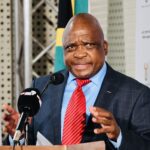The new commander-in-chief has made promises, but how likely is he to deliver?
Hours after former President Jacob Zuma’s resignation, President Cyril Ramaphosa was pictured walking and jogging along the Sea Point promenade.
It wasn’t the first time he’d been spotted doing this.
In January, East Londoners saw him walking along the beach … in Ronald McDonald socks. And on Tuesday morning, the country’s new president arrived at the Gugulethu Sports Complex at 5:30 am in an ANC track suit to lead a brisk 6km group walk to Athlone.
On that day he told journalists he usually walks 10km each morning and wants to inspire South Africans to live healthier lives.
But is he as serious about health issues on a policy level as he is about his personal health?
We look at the three health promises Ramaphosa made in his State of the Nation address: were they followed through in the budget and how likely are they to materalise?
1. Promise: 2-million more people on ARVs
What Ramaphosa said:
“This year, we will take the next critical steps to eliminate HIV from our midst. By scaling up our testing and treating campaign, we will initiate an additional two million people on antiretroviral treatment by December 2020.”
What is it about?
South Africa has the world’s largest HIV treatment programme. According to the national health department, about 60% — or 4.2-million of the country’s just over 7 million HIV-infected people — are on lifelong antiretroviral (ARV) treatment. Although the bulk of these people receive treatment via the state, about 300 000 collect their pills from the private sector.
Approximately 12.6% of South Africans are HIV positive, Stats SA’s 2017 mid-year estimates found.
Since the country’s national HIV treatment programme was rolled out in 2004, life expectancy has increased from 54.9 years in 2002 to 64 in 2017, Stats SA data show. Experts agree that ARVs can at least be partly credited for this. Aids deaths have also decreased significantly: from 254 883 (41% of the total deaths in the country) in 2002 to 125 755 (25.03% of total deaths) in 2017, according to Stats SA.
Studies have shown that ARVs don’t only allow people with HIV to live longer, but that, when used correctly, they drugs decrease the amount of HIV in someone’s blood to such a low level that it becomes impossible for infected people to transmit the virus to others.
Therefore, the more HIV-positive people we put on ARVs, the slower the virus is likely to spread, provided that those on ARVs use their pills correctly.
In September 2016, South Africa adopted a “test and treat” policy where anyone who tests HIV positive qualifies for free antiretroviral treatment. The ideal for the country would be to have every HIV-infected person on ARVs. But for that to happen, everyone who has contracted the virus, would need to know that they are infected. And, in 2016, about a quarter of people with HIV in the country, didn’t know they were HIV positive, health department statistics show.
The United Nations has set goals known as the 90-90-90 targets for countries like South Africa. By 2020, 90% of people need to know their HIV status, of those diagnosed with HIV infection, 90% would need to be on antiretroviral treatment, and of those on treatment 90% need to be virologically suppressed (have virus levels low enough so that they can’t transmit HIV).
It’s within this context that the president’s promise of putting 2-million more people on ARVs fits.
What did the 2018 budget speech say about it?
The finance minister’s budget speech didn’t refer to this, but the government’s “2018 estimates of national expenditure” document shows that the health department aims to have 6-million people on ARVs by 2020/2021, which is more or less 2-million more than the current number on ARVs in the state sector (3.9-million).
An additional R1-billion will be allocated to the HIV and Aids, tuberculosis, and maternal and child health programme in 2020/21 for “the comprehensive HIV, Aids and TB grant for provinces” to provide ARVs to an estimated 6-million people. As a result of the extra allocation in 2020/21, funding for the grant increases by 11.6% per year, with a total budget of R66.4-billion between 2017/18 and 2020/21.
Overall, government will be spending R205 billion on health in 2018/19 growing to R240 billion by 2020/21.
Provision has also been made to increase funding for community health workers, who play an important part in ensuring that people take their treatment correctly.
How likely is this promise to be delivered?
The budget makes provision for this promise, but the HIV lobby group, Treatment Action Campaign (TAC), has raised concerns about the lack of details on how to deal with challenges that might arise with putting millions more people on ARVs. TAC General secretary Anele Yawa warns that the public health system is not yet equipped to ensure quality service.
“If we put 2-million more people on ARVs, we need to know that our health system will be given enough resources to cope with the bigger load of people,” he says.
We need to know that we will have more nurses to do HIV tests and initiate treatment, that there will be no stock-outs of ARVs, and that our system will be able to keep the people on treatment for the rest of their lives. In other words: help them to adhere to their pills.”
2. Promise: The National Health Insurance scheme is here
What Ramaphosa said:
“The time has now arrived to finally implement universal health coverage through the National Health Insurance. The NHI Bill is now ready to be processed through government and will be submitted to Parliament in the next few weeks. Certain NHI projects targeting the most vulnerable people in society will commence in April this year.”
What is it about?
Under the NHI, the government will pool private and public funding to become the largest purchaser of healthcare services from private and government providers. By doing this, Health Minister Aaron Motsoaledi argues, South Africa will be able to provide better and more equitable care for all South Africans. The universal healthcare scheme will be rolled out in phases and will be complete by 2025, he told Bhekisisa in July 2017.
Estimations of the annual cost of the scheme vary, but some experts say it could be as high as R400-billion.
South Africa is not alone in moving towards an NHI. Worldwide, countries agreed to achieve universal health coverage by 2030 as part of the latest round of development goals.
What did the 2018 budget speech say about it?
The latest budget shows increasing allocations to the NHI over the next three years, beginning with R700-million in the coming financial year and peaking at an extra R2.1-billion for the scheme by 2020/21. By 2020/21, the country will be shelling out R9.1-billion to fund the NHI, largely through gradual reductions in state subsidies for private medical aid members, also known as medical aid tax credits, which will amount to R4.2 billion.
But Russell Rensburg of the Rural Health Advocacy Project warns that Gigaba’s additional funding for the NHI still falls far short of the R20-billion Motsoaledi had hoped to collect from cutting these credits.
On the ground, South Africans can expect this extra funding to translate into better school health services for children struggling with eyesight and hearing problems and at-risk pregnant women. The government will also be looking to throw some of this money towards private general practitioners, paying them set, annual per patient prices to accommodate government patients in existing private practices.
But to fully introduce the NHI, almost a dozen pieces of existing health legislation will have to be amended. To do that, as well as to sketch out the role of private medical aids in the NHI era, for instance, ministerial advisory teams have been created. Gigaba’s budget sets aside R268-million to support their work as well as strengthen health technology and fund programmes to prevent rising rates of noncommunicable diseases.
How likely is this promise to be delivered?
Gigaba’s budget is a serious reality check to the optimism of Ramaphosa’s State of the Nation address, Rensburg says.
“In the 2017 budget, the former minister of finance spoke about a transitional NHI fund that would be financed through medical aid credits. Sadly, that doesn’t filter through in this budget, and there isn’t an introduction of such a fund,” he explains.
Rensburg says the government may have felt it had little choice other than to increase VAT and personal income tax to make up for shortfalls.
Its unwillingness to drop the final axe on medical aid tax credits, has spared the pockets of some but may have left the NHI more underfunded than before.
[WATCH] Will the National Health Insurance cost you more money?
3. Promise: We will launch a national cancer campaign within three months
What Ramaphosa said:
“We will also need to confront lifestyle diseases such as high blood pressure, diabetes, cancers and cardiovascular diseases. In the next three months, we will launch a huge cancer campaign similar to the HIV counselling and testing campaign. This will also involve the private sector as we need to mobilise all resources to fight this disease.”
What is it about?
Since June 2017, cancer services in KwaZulu-Natal have been at a near standstill. There are only two oncologists and three working treatment machines in the province, according to a KwaZulu-Natal health department statement released in early February. With a dearth of specialists, the province can now no longer train new oncologists, says Health Professions Council of South Africa spokesperson Priscilla Sekhonyana. Three oncologists from the Johannesburg-based nonprofit Wits Health Consortium were due to begin seeing patients in Durban this week.
Just months after KwaZulu-Natal’s cancer services collapsed, the country passed the National Policy Framework and Strategy on Cancer. It debuts alongside three new plans to increase cervical and breast cancer screening and treatment as well as end-of-life care and pain management.
[WATCH] How cancer services crumbled in KZN
What did the 2018 budget speech say about it?
As part of NHI funding, R4-billion in the next three years will go to fund services such as school health screenings, enlisting private GPs and to expand screening and treatment for breast and cervical cancers.The budget doesn’t break down how much of this amount has been allocated to cancer services.
To prevent cervical cancer, the country will aim to vaccinate 90% of girls in Grade 4 against the human papilloma virus (HPV) by 2021. HPV is known to cause cervical cancer. To do this, the state will increase spending on the vaccination programme by about 10% over the next three years.
How likely is this promise to be delivered?
Gigaba’s budget is short of detail about how campaigns and cancer plans will be funded.
Provinces such as KwaZulu-Natal have already begun to increase mobile screening services, but efforts to increase cancer treatment may prove challenging. The country continues to battle high cancer treatment costs. In 2016, the national health department approached pharmaceutical company Roche to negotiate a price cut for its breast cancer drug Herceptin, which retails for about R500 000 for a treatment course. Earlier this month, Motsoaledi bemoaned that the drug still costs about R408 000 per patient in an interview with the South African Broadcasting Corporation. Oncologists, meanwhile, remain scarce in the country’s public sector. A study published in the 2014/15 South African Health Review found that just 4 986 medical specialists of any kind worked for the state in 2015.
The shortage of health workers qualified to implement ambitious cancer plans, will prove to be a stumbling block for Ramaphosa’s plans. On Monday, the chief executive officer of the Cancer Association of South Africa, Elize Joubert, warned: “One of our biggest concerns is that there aren’t enough oncology doctors and nurses to implement the new strategy.”













